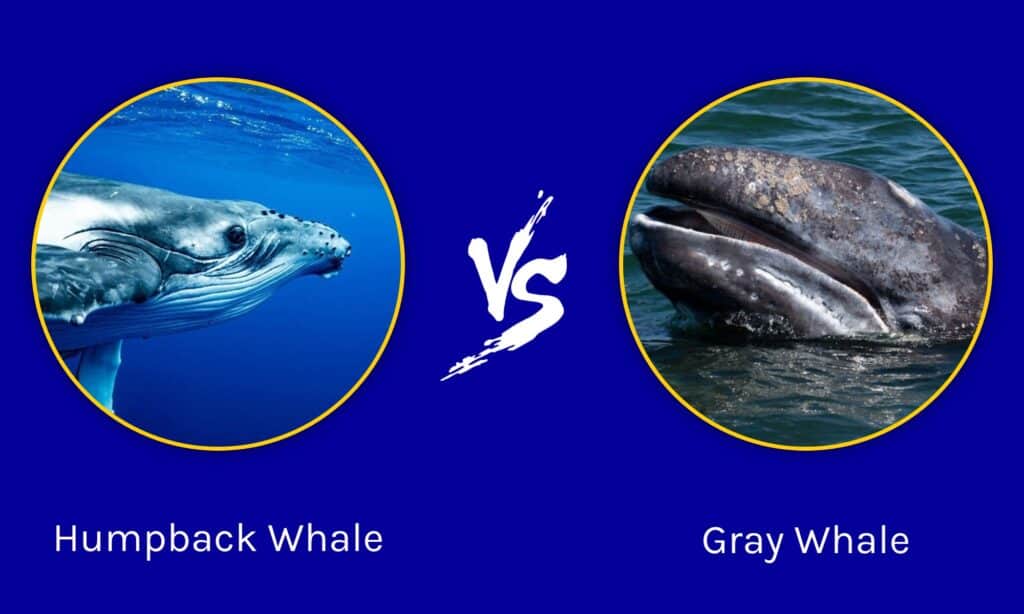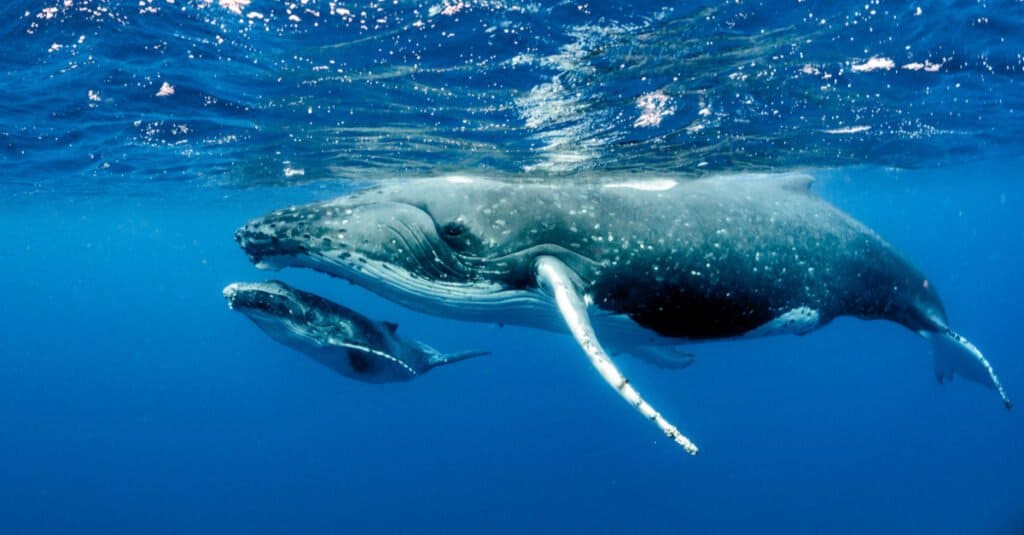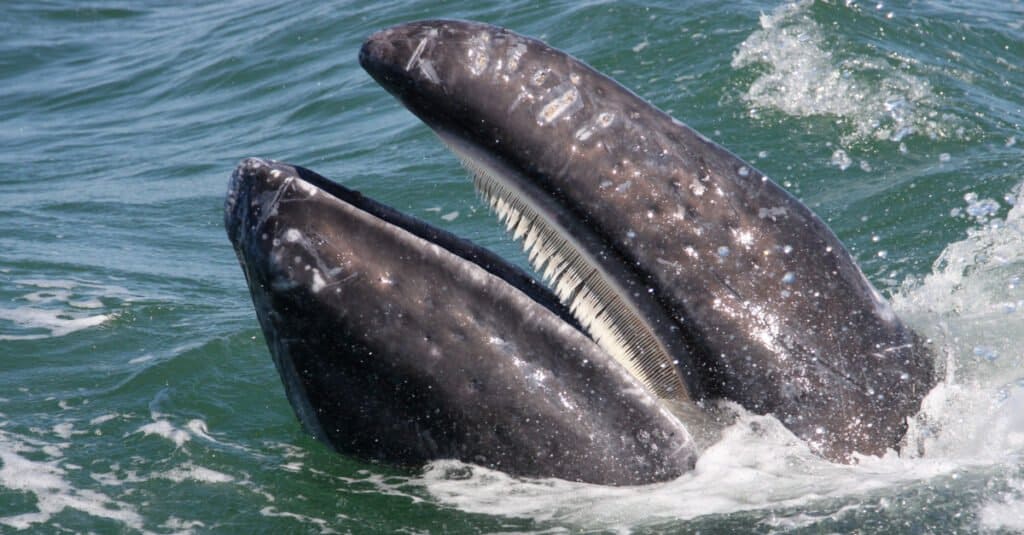Gray whales and humpback whales are among 14 extant species of baleen whales. They are large whales with baleen plates that can sometimes be challenging to differentiate. It’s even more difficult because the gray whale and the humpback can sometimes be seen in the same color. But, this doesn’t make them the same. Let’s explore the differences between a gray whale and a humpback in detail.
Comparing a Gray Whale and a Humpback

| Gray Whale | Humpback | |
|---|---|---|
| Taxonomy | -Belongs to the family Eschritidae | -Belongs to the family Balaenopteridae |
| Physical Appearance | -Color: Gray in color -Length: 49ft -Weight: 90,000 lbs -Baleen Plates: 130-180 | -Color: Ranges from gray to white to black -Length: 48ft- 62ft -Weight: 80,000 – 200,000 lbs -Baleen Plates: 270-400 |
| Habitat | -Found in Eastern and Western parts of the North Pacific Ocean | -Wider range. -They live in the Atlantic ocean, Pacific Ocean, Arctic Ocean, and some of the waters bordering Antarctica |
| Behavior and Diet | -Can travel long distances of up to 12,700 miles. -Bottom feeders -Diet comprises invertebrates like amphipods | -Can travel about 3,000 miles -Feeds beneath the water surface -Diet comprises krill, salmon, haddock, e.t.c. |
| Reproduction and Lifespan | -Gestation lasts for 12 to 13 months -Lifespan is between 50-60 years | -Gestation lasts for 11 months -Lifespan is between 45-50 years |
The Key Differences Between A Gray Whale And A Humpback
The key differences between a gray whale and a humpback are their physical appearance, diet, habitat, reproduction, and lifespan. Humpback whales weigh more than gray whales and are generally longer. Gray whales are bottom feeders, while humpbacks are not. Furthermore, humpbacks have a wider range than gray whales. But that is not all.
Let’s explore the differences between a gray whale and a humpback in detail!
Gray Whale Vs. Humpback: Taxonomy
Gray whales and humpbacks belong to the baleen whales consisting of 14 species in total. However, they come from different families and genera. The gray whale belongs to the genus Eschrichtius robustus, and their scientific family is Eschrichtiidae.
On the other hand, the humpback whale belongs to the genus Megaptera novaeangliae and their scientific family is Balaenopteridae.
Gray Whale Vs. Humpback: Physical Appearance

Humpback whales measure up to 49 feet long and 90,000 pounds in weight.
©Imagine Earth Photography/Shutterstock.com
Just like their name indicates, gray whales are gray in color. They are large and measure up to 49 feet in length and 90,000 pounds in weight. Although gray whales don’t have dorsal fins, they have wide and short pad-like pectoral flippers. In place of their dorsal fins are humps and right below them are tiny bumps that travel all the way down to their flukes. Besides, they are easily differentiated because they have flatter throat grooves than humpbacks. They have 130 to 180 baleen plates that help them filter food while feeding.
On the other hand, the bodies of humpbacks range between black and grey. They are easily distinguished from gray whales with their white underbellies. Humpbacks measure up to 48 feet to 62 feet in length and 80,000 to 200,000 lbs in weight. Unlike their counterparts, they have both pectoral flippers and dorsal fins. The pectoral flippers are long and are close to their eyes, whereas the dorsal fins are small. They have more swollen throat gloves than their counterparts.
Humpbacks have bumps too, but these bumps are concentrated around their heads only. They have 270 to 400 overlapping baleen plates that help them filter food while eating.
Gray Whale Vs. Humpback: Distribution and Habitat
Gray whales have a shorter range than humpbacks. Gray whales are easily found in the Eastern and Western parts of the North Pacific Ocean. But, they often migrate between seasons to feed or breed. In summer, the ones in the Eastern region migrate to the Pacific coasts and feed in waters located in Northern California, Oregon, British Columbia, and Washington. In the fall, they migrate to the North American coasts, specifically in Mexico and Baja California, where they breed.
Humpbacks have a wider range than gray whales. They are well adapted to tropical and polar waters. So, they live in the Atlantic ocean, Pacific Ocean, Arctic Ocean, and some of the waters bordering Antarctica. Similarly, humpbacks migrate between seasons to feed or breed.
Gray Whale Vs. Humpback: Behavior and Diet

The gray whale is a bottom feeder.
©Mogens Trolle/Shutterstock.com
Gray whales are migratory aquatic mammals. They can travel long distances of up to 12,700 miles. They are capable of migrating alone or in small groups. Sometimes, migrating groups eventually split up. Occasionally, they come together to feed or breed, but social groups formed are not long-lasting.
Interestingly, gray whales are bottom feeders, and their diet comprises primarily invertebrates like amphipods. They usually suck their food and filter them with their baleen plates. To feed, they go to the bottom and roll with their sides while sucking their food.
The social behavior of humpbacks is similar to that of gray whales. They are migratory aquatic animals that can travel in groups or alone. But they don’t travel long distances like gray whales and can cover about only 3,000 miles. Besides, social groups formed are usually transient.
In contrast to the gray whale’s feeding habits, humpbacks feed right beneath the water surface. Their diet primarily consists of krill, salmon, herring, haddock, sand lance, pollock, and other small fish. Male humpbacks are popular for making sounds that can travel about 20 miles.
Gray Whale Vs. Humpback: Reproduction and Lifespan

Gray whales have a lifespan of 50 to 60 years.
©jo Crebbin/Shutterstock.com
Mating season for both gray whales and humpbacks is usually biennial. Besides, both whales are polygynous and usually breed during winter. They usually migrate from their summer feeding camps to their wintering zones during breeding seasons. For gray whales, breeding season usually falls in the winter, and gestation lasts for 12 to 13 months. On average, a gray whale’s lifespan is between 50-60 years.
In contrast, the gestation period for humpbacks lasts eleven and a half months. While mothers are protective of calves, the males are usually not affectionate or attached to their offspring. On average, a humpback’s lifespan is between 45-50 years.
The photo featured at the top of this post is © Imagine Earth Photography/Shutterstock.com
Thank you for reading! Have some feedback for us? Contact the AZ Animals editorial team.






